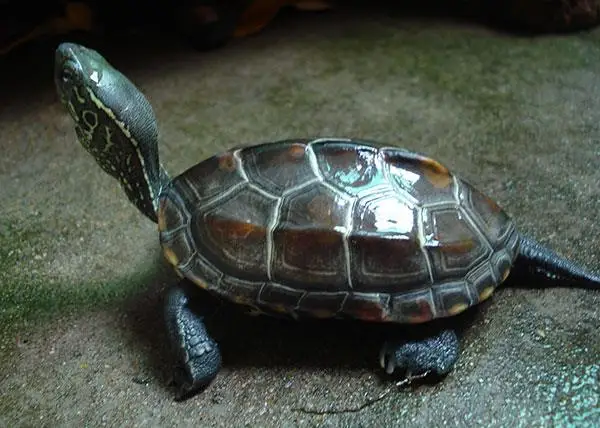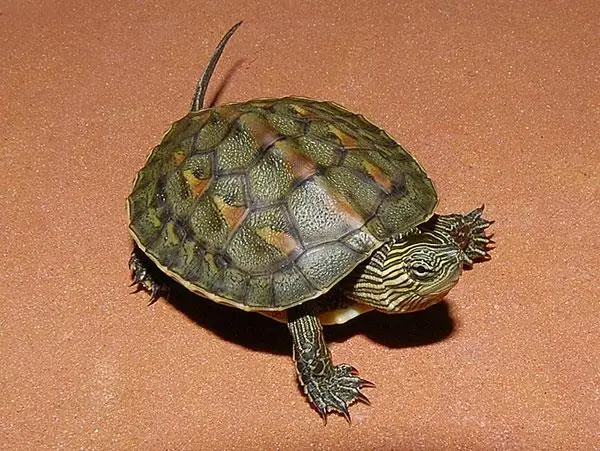Variety Overview
English Name: Chinese Pond Turtle
Also Known As: Golden Turtle, Golden Thread Turtle, Black Turtle, Mud Turtle, Mountain Turtle, Stinky Green Turtle, Longevity Turtle
Origin: China, Japan, South Korea
Price Range:approximately $0.75~$7.50 USD
Lifespan: 20~30 years
Morphological Features and Identification
The Chinese pond turtle (Chinemys reevesii) features a long oval body with a slightly raised shell marked by three longitudinal ridges, the central one being most prominent. The head is colored black-olive, with smooth skin in front and fine scales behind. Its plastron is flat with a notch at the rear end. The neck, limbs, and exposed skin are gray-black or black-olive. Males are smaller with longer tails that emit an odor. Females have carapaces that range from light to dark brown, blackish-brown plastrons, shorter tails, and lack any distinctive smell.
Yellow linear markings adorn the sides of their heads and necks, featuring three longitudinal ridges without serrated rear edges; males have either completely black backs or predominantly black bodies, while females display brown coloration with slightly yellowish undersides and dark brown spots; their limbs are relatively flat with claws and fully webbed toes.

Maintenance Tips
Breeding Environment
The turtle pond should be located in a place sheltered from wind and exposed to sunlight with easy access to water:
- Land: The ideal depth is between 1-1.5 meters with a pool bottom slope ratio of either 1:2 or 1:3. Ensure there are both inlets and outlets for water flow. Cover about one-third of the pond’s surface area with duckweed or other aquatic plants like water hyacinth for shading purposes. Build walls around the pond that are between 0.5-1 meter high with foundations buried at least 30 cm deep to prevent escape attempts by turtles. Leave an open space measuring approximately 1.5 meters by 1 meter inside these walls; larger ponds can have several such spaces or create a small island occupying about five percent of total area where sand can be piled up for nesting purposes.
- Concrete Ground: Depths should range from 1.3-1.5 meters while maintaining a water level between 0.5-0.8 meters over soil layers about 20 cm thick at bottom levels equipped similarly with efficient drainage systems including islands covered in grass where sand piles are strategically placed among them too; adult turtle density here typically ranges five-seven per square meter but mustn’t exceed ten overall.
Living spaces directly impact their healthy growth affecting breeding outcomes significantly thus choosing southern-facing sites abundant sunlight fresh air rich sources easy draining devoid pollutants noise crucially important aspects considered when setting up farms,
Multiple environmental factors influence life primarily through quality maintained regularly monitored adjusted preventing harmful substances like chromium cadmium phenol aldehyde hydrogen compounds sulfides infiltrating threatening both their survival human health alike,
Creating non-polluting ecological environments involves leaving strips land around ponds planted grasses trees covered sandy layers adjusting surrounding temperatures providing shading nesting areas during summers low temperatures respectively,
Planting limited quantities roughly one-third aquatic plants helps absorb heavy metals control ammonia nitrogen concentrations stabilize temperatures offering habitats young ones basking additionally providing mating shaded spots,
Stocking tilapia crucian carp mandarin snakehead fishes approximately one-two per square meter stirs bottom mud accelerating organic matter decomposition consuming feces algae maintaining ecological balance within ponds overall,
Water Level Requirements
Grass turtles being proficient swimmers often assumed needing only stones platforms above surface deeper waters offering aesthetic appeal easier maintenance mixed rearing however deeper levels necessitate increased effort reaching surfaces potentially exhausting weaker individuals risking drowning hence ideal setup includes shallow sections barely covering shells facilitating resting breathing basking optimal conditions met through creating islands within deep shallow zones sandy areas basking rocks,
Water Change Frequency
Continuous excretion leftover feed decomposition produces harmful substances deteriorating quality affecting normal activities leading diseases death timely frequent changes ensure freshness promoting growth,
Common belief cleanest best natural waters containing beneficial bacteria maintaining health balances artificial setups lacking causing illnesses malnutrition partial full changes recommended based conditions:
Partial dilution siphoning removing debris quarter volume replaced same temperature dechlorinated warmed twice weekly autumn-winter thrice spring-summer,
Full changes heavily polluted requiring equipment removal thorough cleaning sponge cloth scrubbing walls bottoms rinsing gravel plants fortnightly monthly necessary immediate drastic variations,
Filters reduce daily necessity half-monthly replacing third fresh unless feeding contamination suggests otherwise daily third advisable absence cleanliness dependent complete change best achieved sun-exposed tapwater two-day dechlorination chemical method sodium thiosulfate proportioned ten kilograms per gram stirring dissolving usable;
Summer full change ten-fifteen days brownish-blue-green excessive fertility immediate post-feeding three-four hours high temperatures winter hibernation minimal none needed,
Water Temperature Requirements
Post “Lichun” warming awakens initiating growth reproduction practices showing direct correlations optimal fastest growth observed trials:
Male adults significant weight gain twenty-three twenty-six degrees Celsius fastest twenty-three second worst thirty-five female similar fastest second worst same conditions females grow thirty-four point two percent faster juveniles fastest second worst degrees Celsius,
Water Quality Requirements
Being aquatic lung-breathing naturally reliant interestingly dietary excretory functions occurring within hence essential suitable environments clear transparency thirty centimeters variable seasonal depths adjusting accordingly spring shallow approximately half-meter summer deeper autumn decreasing winter stable avoiding drastic fluctuations ensuring survival nutrient utilization preventing mortality tapwater neutral hardness pH suitable general species exceptions requiring attention rust removal methods exposure days dark four-six days chemical sodium thiosulfate ratio ten kilograms per gram stirring dissolving usable.

Feeding Techniques
Hatchling turtles are very delicate and require separate care and meticulous management. Typically, a separate cement pool is constructed where one-third is land and two-thirds is water. Fine feeds like cooked egg whites, egg yolks, cooked noodles, rice, minced fish, and shrimp should be provided appropriately. It’s generally best for hatchlings to overwinter separately from adult turtles during their first year. The common method for hatchlings to overwinter involves placing a small wooden tray indoors filled with 20-30 cm of sand. The hatchlings are placed in the sand with an additional 0.5 cm layer of fine sand sprinkled on top. Cover them with gauze and spray some warm water as needed to ensure safe overwintering.
Adult turtles have a varied diet that includes small fish, small shrimp, snails, mussel meat, vegetables, rice, and wheat. They typically start eating when the water temperature rises above 15°C (59°F). Their peak feeding period is from June to September; food intake decreases starting in November. When the water temperature drops below 15°C (59°F), they enter hibernation mode. During spring and autumn when temperatures are relatively low, feeding should occur between 8-9 AM. In midsummer when turtles are active in the morning and evening, feeding should take place between 4-5 PM. Turtles swallow food while submerged in water; they consume about 4% of their body weight each feeding session every other day. Leftover food should be promptly cleaned up after feeding to prevent pollution that could cause harm. Water needs to be changed frequently to maintain freshness. Turtle growth is closely related to feed quality; regularly providing animal-based feed can increase their weight by approximately 50 grams per month.
